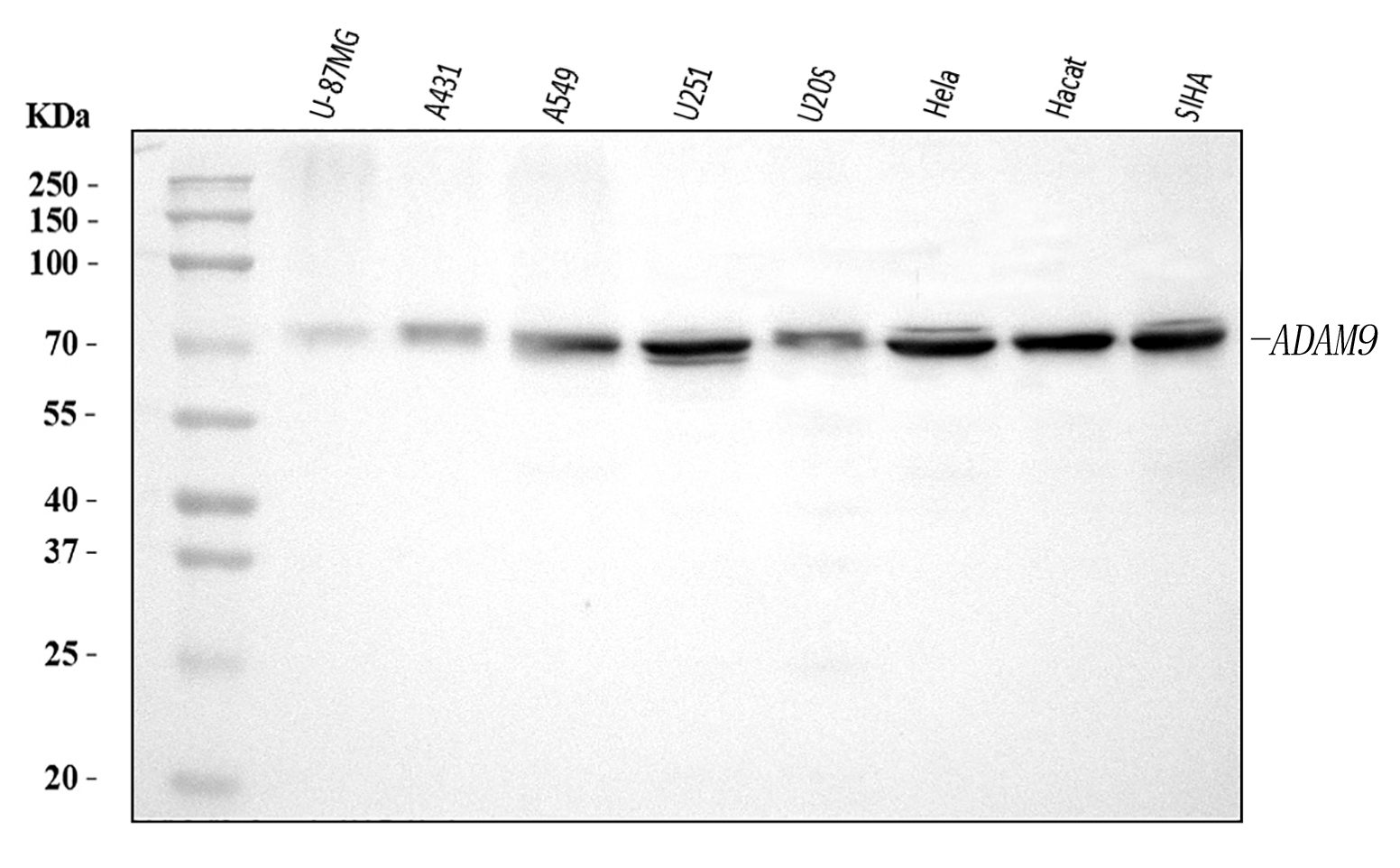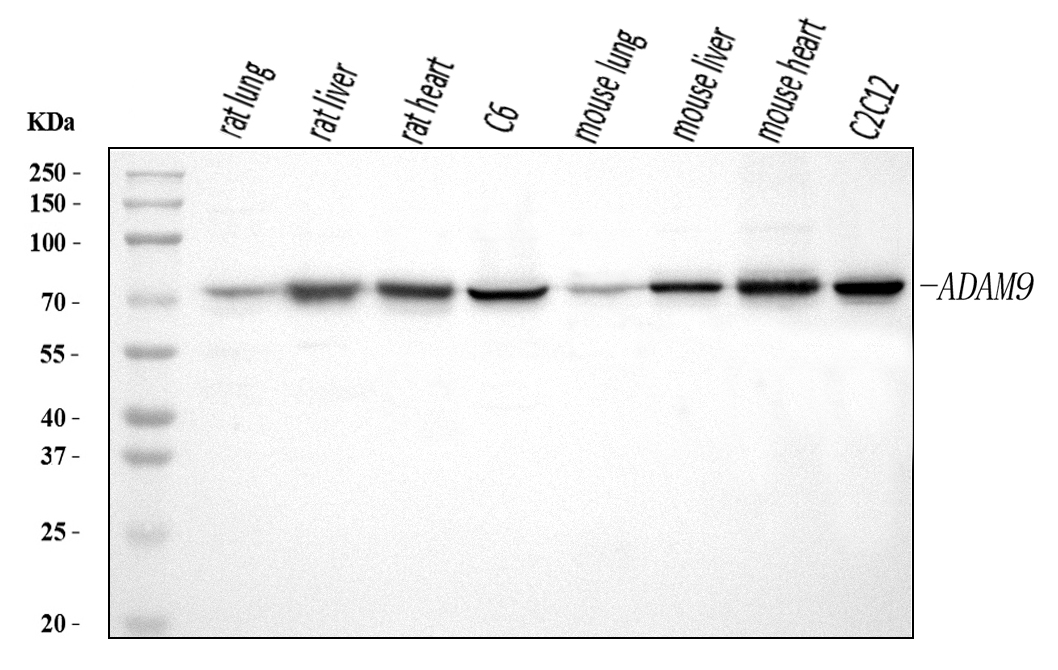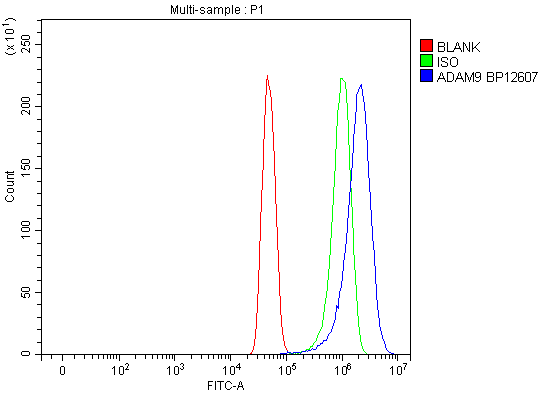| Western blot (WB): | 1:500-2000 |
| Flow Cytometry (Fixed): | 1:50-200 |
| Enzyme linked immunosorbent assay (ELISA): | 1:100-1000 |

Figure 1. Western blot analysis of ADAM9 using anti-ADAM9 antibody (A03074-2). The sample well of each lane was loaded with 30 ug of sample under reducing conditions.
Lane 1: U-87MG whole cell lysates,
Lane 2: A431 whole cell lysates,
Lane 3: A549 whole cell lysates,
Lane 4: U251 whole cell lysates,
Lane 5: U2OS whole cell lysates,
Lane 6: HELA whole cell lysates,
Lane 7: HACAT whole cell lysates,
Lane 8: SIHA whole cell lysates.
After electrophoresis, proteins were transferred to a membrane. Then the membrane was incubated with rabbit anti-ADAM9 antigen affinity purified polyclonal antibody (A03074-2) at a dilution of 1:1000 and probed with a goat anti-rabbit IgG-HRP secondary antibody (Catalog # BA1054). The signal is developed using ECL Plus Western Blotting Substrate (Catalog # AR1197). A specific band was detected for ADAM9 at approximately 75 kDa/100 kDa. The expected band size for ADAM9 is at 91 kDa.

Figure 2. Western blot analysis of ADAM9 using anti-ADAM9 antibody (A03074-2). The sample well of each lane was loaded with 30 ug of sample under reducing conditions.
Lane 1: rat lung tissue lysates,
Lane 2: rat liver tissue lysates,
Lane 3: rat heart tissue lysates,
Lane 4: C6 whole cell lysates,
Lane 5: mouse lung tissue lysates,
Lane 6: mouse liver tissue lysates,
Lane 7: mouse heart tissue lysates,
Lane 8: C2C12 whole cell lysates.
After electrophoresis, proteins were transferred to a membrane. Then the membrane was incubated with rabbit anti-ADAM9 antigen affinity purified polyclonal antibody (A03074-2) at a dilution of 1:1000 and probed with a goat anti-rabbit IgG-HRP secondary antibody (Catalog # BA1054). The signal is developed using ECL Plus Western Blotting Substrate (Catalog # AR1197). A specific band was detected for ADAM9 at approximately 75 kDa/100 kDa. The expected band size for ADAM9 is at 91 kDa.

Figure 3. Flow Cytometry analysis of U251 cells using anti-ADAM9 antibody (A03074-2).
Overlay histogram showing U251 cells stained with A03074-2 (Blue line). To facilitate intracellular staining, cells were fixed with 4% paraformaldehyde and permeabilized with permeabilization buffer. The cells were blocked with 10% normal goat serum. And then incubated with rabbit anti-ADAM9 Antibody (A03074-2) at 1:100 dilution for 30 min at 20°C. DyLight®488 conjugated goat anti-rabbit IgG (BA1127) was used as secondary antibody at 1:100 dilution for 30 minutes at 20°C. Isotype control antibody (Green line) was rabbit IgG at 1:100 dilution used under the same conditions. Unlabelled sample without incubation with primary antibody and secondary antibody (Red line) was used as a blank control.

Figure 1. Western blot analysis of ADAM9 using anti-ADAM9 antibody (A03074-2). The sample well of each lane was loaded with 30 ug of sample under reducing conditions.
Lane 1: U-87MG whole cell lysates,
Lane 2: A431 whole cell lysates,
Lane 3: A549 whole cell lysates,
Lane 4: U251 whole cell lysates,
Lane 5: U2OS whole cell lysates,
Lane 6: HELA whole cell lysates,
Lane 7: HACAT whole cell lysates,
Lane 8: SIHA whole cell lysates.
After electrophoresis, proteins were transferred to a membrane. Then the membrane was incubated with rabbit anti-ADAM9 antigen affinity purified polyclonal antibody (A03074-2) at a dilution of 1:1000 and probed with a goat anti-rabbit IgG-HRP secondary antibody (Catalog # BA1054). The signal is developed using ECL Plus Western Blotting Substrate (Catalog # AR1197). A specific band was detected for ADAM9 at approximately 75 kDa/100 kDa. The expected band size for ADAM9 is at 91 kDa.

Figure 2. Western blot analysis of ADAM9 using anti-ADAM9 antibody (A03074-2). The sample well of each lane was loaded with 30 ug of sample under reducing conditions.
Lane 1: rat lung tissue lysates,
Lane 2: rat liver tissue lysates,
Lane 3: rat heart tissue lysates,
Lane 4: C6 whole cell lysates,
Lane 5: mouse lung tissue lysates,
Lane 6: mouse liver tissue lysates,
Lane 7: mouse heart tissue lysates,
Lane 8: C2C12 whole cell lysates.
After electrophoresis, proteins were transferred to a membrane. Then the membrane was incubated with rabbit anti-ADAM9 antigen affinity purified polyclonal antibody (A03074-2) at a dilution of 1:1000 and probed with a goat anti-rabbit IgG-HRP secondary antibody (Catalog # BA1054). The signal is developed using ECL Plus Western Blotting Substrate (Catalog # AR1197). A specific band was detected for ADAM9 at approximately 75 kDa/100 kDa. The expected band size for ADAM9 is at 91 kDa.

Figure 3. Flow Cytometry analysis of U251 cells using anti-ADAM9 antibody (A03074-2).
Overlay histogram showing U251 cells stained with A03074-2 (Blue line). To facilitate intracellular staining, cells were fixed with 4% paraformaldehyde and permeabilized with permeabilization buffer. The cells were blocked with 10% normal goat serum. And then incubated with rabbit anti-ADAM9 Antibody (A03074-2) at 1:100 dilution for 30 min at 20°C. DyLight®488 conjugated goat anti-rabbit IgG (BA1127) was used as secondary antibody at 1:100 dilution for 30 minutes at 20°C. Isotype control antibody (Green line) was rabbit IgG at 1:100 dilution used under the same conditions. Unlabelled sample without incubation with primary antibody and secondary antibody (Red line) was used as a blank control.




